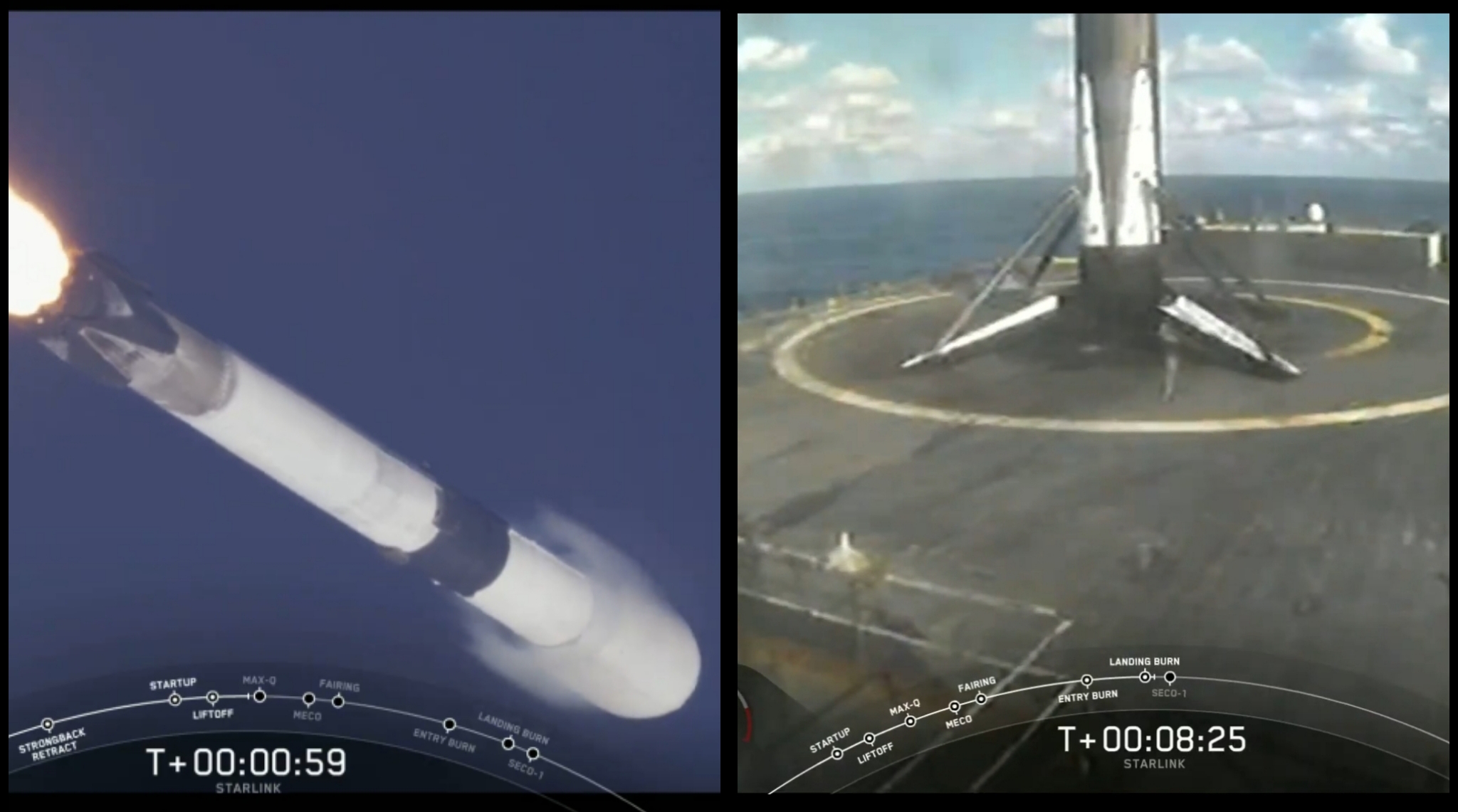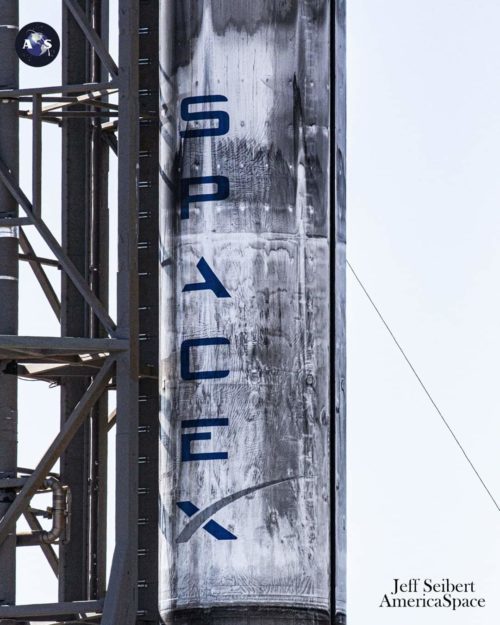
For the sixth time in just over a year, SpaceX has launched a Falcon 9 core on a third occasion, following Wednesday’s rousing 9:06 a.m. EST liftoff of the veteran B1051 booster, together with a sparkling-new second stage and the latest batch of 60 Starlink low-orbiting internet communications satellites.
Coming only a few days after the triumphant In-Flight Abort Test of the Crew Dragon spacecraft—whose success was tempered by the intentional destruction of the four-times-flown B1046 core—this latest flight is the third SpaceX launch of January and marks an impressive start to a busy 2020 manifest.
B1051 is a member of SpaceX’s upgraded Block 5 Falcon 9 fleet, characterized by uprared thrust on its Merlin 1D+ engine suite, strengthened landing legs, enhanced flight control systems and the capacity to withstand an intensified heating regime as it returns from higher-energy launches towards geostationary altitude. This particular booster core first saw service on 2 March 2019, when it lofted Demo-1 of the Crew Dragon into orbit from Pad 39A at the Kennedy Space Center (KSC), before returning to a smooth touchdown on the Autonomous Spaceport Drone Ship (ASDS) “Of Course I Still Love You”, in the Atlantic Ocean.
It was then refurbished for its second mission on 12 June, a mere 102 days later, where it delivered Canada’s Radarsat Constellation Mission (RCM) into orbit from Space Launch Complex (SLC)-4E at Vandenberg Air Force Base, Calif. B1051 returned from its second outing to achieve a picture-perfect “ground” touchdown on Landing Zone (LZ)-4 at Vandenberg, marking only the second occasion that a Falcon 9 core had successfully made landfall on the West Coast.
Original plans to fly this mission as early as Tuesday, 21 January, appeared to go well, with the Falcon 9 and its pre-integrated Starlink payload “stack” rolled horizontally out to Space Launch Complex (SLC)-40 at Cape Canaveral Air Force Station, Fla., one day prior. The nine Merlin 1D+ first-stage engines were static-fired that same day, although SpaceX expressed caution about attempting a launch the following morning. “Due to extreme weather in the recovery area,” the organization noted on Twitter late on the 20th, “team is evaluating best launch opportunity.” With crosswinds expected to reach 60 mph (96 km/h), the safety and stability implications both for the East Coast-based Autonomous Spaceport Drone Ship (ASDS), “Of Course I Still Love You”, and for the returning B1051 itself, were simply too significant for SpaceX to risk. Hopes of flying on Friday, 24 January, also came to nothing, so unfavorable were conditions in the recovery area, prompting a slip to Monday, 27 January.
And Monday had barely a 50-percent likelihood of acceptable weather. Unsurprisingly, with strong upper-level winds in the recovery area a primary concern, SpaceX announced that it was standing down from Monday’s attempt. “Now targeting Wednesday, January 29 at 9:06 a.m. for launch of Starlink,” it was noted, “due to poor weather in the recovery area.” Weather on Wednesday was predicted to improve dramatically to about 80-percent-favorable. “Weak high pressure will be in control of the weather across Florida today, as the next system in the active pattern moves across the northern Gulf of Mexico late tonight,” noted the 45th Weather Squadron in its L-1 briefing on Tuesday morning. “This system is expected to remain well west of the Spaceport during the launch window, with increasing high clouds overspreading the region. The main concern will be light easterly winds bringing onshore-moving low-level cumulus clouds.”

SpaceX pressed directly into Wednesday’s attempt with far greater optimism and fueling of the booster with liquid oxygen and highly refined rocket-grade kerosene (known as “RP-1”) began about 35 minutes prior to T-0. The Merlin 1D+ first-stage engines were chilled, ahead of ignition, and precisely at 9:06 a.m. EST they flared to life with a combined thrust of 1.5 million pounds (680,000 kg).
B1051 powered into the morning sky, becoming the sixth Falcon 9 to record as many as three launches. Its engines shut down as intended at 2.5 minutes into the ascent, separated and commenced a smooth return back to Earth, alighting on the deck of the ASDS. Meanwhile, the single Merlin 1D+ Vacuum engine of the Falcon 9’s second stage continued the push to orbit and at little over an hour after leaving SLC-40 the next batch of 60 Starlinks began their deployment process. Initial deployment occurred at an altitude of some 180 miles (290 km), with the Starlinks’ own ion-propulsion systems subsequently pushing them into their operational slots at about 340 miles (550 km) above Earth.
As January draws to its close, three missions in a little more than three weeks is an impressive start for SpaceX, which expects to fly more times in 2020 than in any previous year. President Gwynne Shotwell noted recently that she expects Starlink launches every two weeks—potentially achieving 24 missions, in itself a record, beating SpaceX’s current “personal best” of 21 flights, achieved in 2018—together with an already full manifest of other customers.
In addition to Starlink, SpaceX plans to fly the classified Air Force Space Command (AFSPC)-44 mission atop its mammoth Falcon Heavy, at least two Dragon cargo flights to the International Space Station (ISS)—including the first member of its CRS2 second-round Commercial Resupply Services contract with NASA—and the first humans ever to ride a Falcon 9 with the inaugural manned voyage of the Crew Dragon. Three Block III Global Positioning System (GPS) satellites and missions for Argentina, Turkey, South Korea and Germany are also manifested, although as is customary for SpaceX exact dates and times remain to be confirmed.
.
.
FOLLOW AmericaSpace on Facebook and Twitter!
.
.






